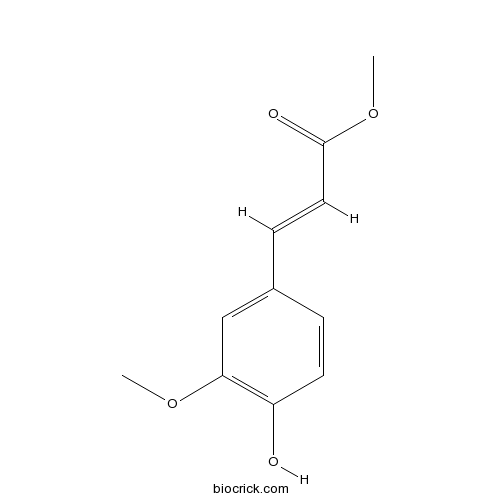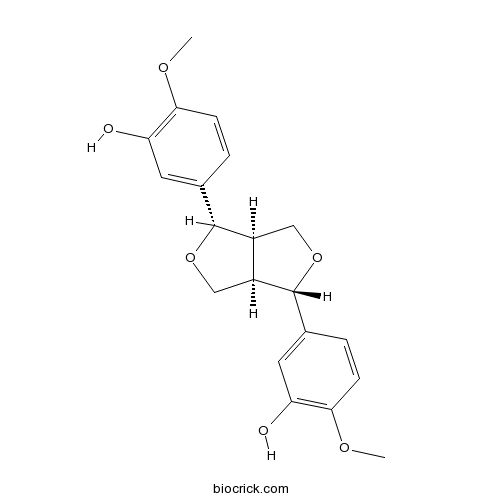Cynanchum auriculatum
Cynanchum auriculatum
1. The products in our compound library are selected from thousands of unique natural products; 2. It has the characteristics of diverse structure, diverse sources and wide coverage of activities; 3. Provide information on the activity of products from major journals, patents and research reports around the world, providing theoretical direction and research basis for further research and screening; 4. Free combination according to the type, source, target and disease of natural product; 5. The compound powder is placed in a covered tube and then discharged into a 10 x 10 cryostat; 6. Transport in ice pack or dry ice pack. Please store it at -20 °C as soon as possible after receiving the product, and use it as soon as possible after opening.
Natural products/compounds from Cynanchum auriculatum
- Cat.No. Product Name CAS Number COA
-
BCN9073
Ferulic Acid Methyl Ester2309-07-1
Instructions

-
BCN7834
Clemaphenol A362606-60-8
Instructions

-
BCN5810
Caudatin38395-02-7
Instructions

Preparation, characterization, antioxidant activity and protective effect against cellular oxidative stress of polysaccharide from Cynanchum auriculatum Royle ex Wight.[Pubmed: 30096394]
None
Preparation, characterization, digestibility and antioxidant activity of quercetin grafted Cynanchum auriculatum starch.[Pubmed: 29572138]
None
Discrimination of Cynanchum wilfordii and Cynanchum auriculatum by terahertz spectroscopic analysis.[Pubmed: 29430752]
Precise identification of botanical origin of plant species is crucial for the quality control of herbal medicine. In Korea, the root part of Cynanchum auriculatum has been misused for C. wilfordii in the herbal drug market due to their morphological similarities. Currently, DNA analysis using the polymerase chain reaction (PCR) method is employed to discriminate between these species.
Antiangiogenic properties of caudatin in vitro and in vivo by suppression of VEGF‑VEGFR2‑AKT/FAK signal axis.[Pubmed: 28990104]
Tumor angiogenesis provides essential nutrients and oxygen to the tumor microenvironment, which is important in tumor growth, progression and metastasis. Inhibition of tumor angiogenesis represents one of the most promising strategies in tumor therapy. The authors previously demonstrated that caudatin, one species of C‑21 steroidal from Cynanchum auriculatum (C. auriculatum), effectively inhibits human glioma growth in vitro and in vivo through triggering cell cycle arrest and apoptosis. However, little information regarding the antiangiogenic properties of caudatin in human glioma is available. Based on the author's previous study, the antiangiogenic effect of caudatin against human glioma was explored, and the underlying mechanism was investigated. The results suggested that caudatin treatment significantly inhibited HUVEC human umbilical vein endothelial cell proliferation, blocked the HUVECs migration, invasion and capillary‑like tube formation by disturbing the vascular endothelial growth factor (VEGF)‑VEGFR2‑protein kinase B (AKT)/focal adhesion kinase (FAK) signal axis. Notably, caudatin treatment abolished the glioma cell growth by suppression of the in vivo angiogenesis, which involved FAK and AKT dephosphorylation and inhibition of VEGF expression. The findings validated the antiangiogenic potential of caudatin in hunting human glioma.
Antitumor evaluation and multiple analysis on different extracted fractions of the root of Cynanchum auriculatum Royle ex Wight.[Pubmed: 28598028]
The root of Cynanchum auriculatum (C. auriculatum) Royle ex Wight has been shown to possess various pharmacological effects and has recently attracted much attention with respect to its potential role in antitumor activity. The C-21 steroidal glycosides are commonly accepted as the major active ingredients of C. auriculatum. In this study, the antitumor abilities of different extracted fractions of the root bark and the root tuber of C. auriculatum were investigated by using a 3-(4,5-dimethylthiazol-2-yl)-2,5-diphenyltetrazolium bromide assay in human cancer cell lines HepG2 and SMMC-7721. The results showed that the chloroform and ethyl acetate fractions of the root tuber suppressed tumor cell growth strongly. To identify and characterize the chemical constituents of different active fractions, an ultra high performance liquid chromatography with triple-quadrupole tandem mass spectrometry method was developed for the simultaneous quantitation of eight C-21 steroidal glycosides. The analysis revealed that the C-21 steroidal glycosides were concentrated in the chloroform and ethyl acetate fractions, and the total contents of different fractions in the root tuber were significantly higher than those of corresponding ones in the root bark. Furthermore, the C-21 steroidal glycosides based on different types of aglucones were prone in different medicinal parts of C. auriculatum.
GC-MS, FTIR and Raman Analysis of Antioxidant Components of Red Pigments from Stemphylium lycopersici.[Pubmed: 28255784]
Many microorganisms can generate pigments with different colours and structures during the growth process. In this study, an endophytic fungus producing red pigments was isolated from Cynanchum auriculatum Royle ex Wight tissue. PCR amplification sequencing was conducted, and phylogenetic analysis was performed on the ITS region sequences. Combined with morphological observation, the fungus was identified as Stemphylium lycopersici. The antioxidant activities of the pigments were evaluated in vitro and showed good antioxidant properties. Ultraviolet (UV), Raman, and Fourier transform infrared (FTIR) spectroscopy and gas chromatography-mass spectroscopy (GC-MS) were used to analyse the pigments' components, which were shown to contain phenolics and anthraquinones. Most of these components have not been previously reported in Stemphylium lycopersici, especially physcione. This study is the first report of Stemphylium lycopersici secondary metabolites and their potential use as red pigments and antioxidants. Further optimisation of the culture conditions of this fungal strain might permit its application for pigment production.


